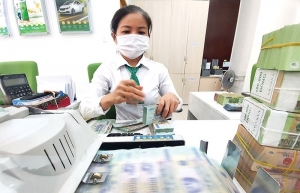Vietnam’s public debt control goals for year within reach
The National Assembly (NA) is scheduled to adopt a resolution on allocating the central budget for 2023 on November 11, paving the way for the government to formulate revenue and spending plans for next year which is expected to see the economy grow 6.5 per cent – lower than the expected rate of about 8 per cent for this year.
Based on the country’s demand for budgets, the government has proposed to the NA that the state budget overspending estimates for next year will be VND455.5 trillion ($19.8 billion), equivalent to 4.42 per cent of GDP – up by about VND82.6 trillion ($3.59 billion) as compared to the estimates for this year.
 |
| By the end of 2023, the economy’s public debt could stand at around 45 per cent of GDP, photo Le Toan |
This includes the overspending for the central budget which will be about VND430 trillion (nearly $18.7 billion) or 4.18 per cent of GDP – including 1.53 per cent for the Programme on Socioeconomic Recovery and Development (PSRD); and the overspending for localities’ coffers which will be as much as VND25 trillion ($1 billion) or 0.24 per cent of GDP. These figures are said by the government to be “very positive” for 2023.
It has also been suggested that the government’s direct debt repayment obligation for next year will be about 19-20 per cent of total state budget revenues – lower than the NA’s permissible limit of 25 per cent.
It is expected that by late 2023, the economy’s public debt will stand at about 44-45 per cent of GDP, the government’s debt around 41-42 per cent of GDP, and foreign debt 41-42 per cent of GDP. These levels are also lower than the NA’s permissible limits (see box).
The government last week reported to the NA that under the Ministry of Finance’s (MoF) fresh statistics, Vietnam’s public debt at the end of this year will likely be about 43-44 per cent of GDP; the government’s debt could hit 40-41 per cent of GDP; and the nation’s foreign debt is expected to be 40-41 per cent of GDP. The government’s direct debt repayment obligation will likely sit at 18-19 per cent of total state budget revenue.
“These forecasts will be lower than the ceiling and the warning threshold fixed by the NA,” said MoF Minister Ho Duc Phoc.
Deputy Prime Minister Le Minh Khai on April 12 released Decision No.448/QD-TTg approving Vietnam’s programme on public debt management for 2022-2024 as well as a strategy on public debt borrowing and payments for the remainder of this year.
In 2022 alone, the government will likely have to use $14.6 billion for debt payments. As for public debt borrowing and payment for this year, the government is expected to borrow a maximum sum of $29.28 billion, including $28.12 billion for the central coffers and $1.16 billion for refinancing.
The MoF reported that the 9-month state budget revenue is estimated to reach $57.7 billion, tantamount to 94 per cent of initial estimates. It is expected that the figure for the whole year will be $70.18 billion – exceeding by $8.8 billion or 14.3 per cent as compared to the target set in November last year by the NA, also up 2.9 per cent against the figure realised last year. Meanwhile, the 9-month budget spending is estimated to be about $47.23 billion – up 5.4 per cent on-year, raising the total figure for the entire year to an expected $85.48 billion.
It is estimated that the total budget deficit for the whole year will be about $15.3 billion or 3.75 per cent of GDP.
The government has also proposed some key targets for the state budget for the 2023-2025 period.
Specifically, total revenues will likely be as much as VND5.1 quadrillion (around $221.7 billion), 84 per cent of which will come from domestic revenues by 2025. Meanwhile, the total expenditure is estimated to be about VND6.4 quadrillion ($278.26 billion).
According to the Executive Board of the International Monetary Fund, which in July worked with Vietnamese authorised agencies on the country’s economic situation and macroeconomic monitoring, 2022’s fiscal policy stance remains supportive to boost the economic recovery through the implementation of the PSRD, which is supported by a $15 billion fiscal and monetary policy.
“On the revenue side, priorities focus on implementing policy measures such as exemption, reduction, payment extension of taxes, fees, and land rent. On the expenditure side, the authorities prioritise spending for pandemic prevention and control, social security and safety net, and infrastructure investment,” the board said. “The authorities intend to increase the budget deficit to 4.7 per cent of GDP to implement the PSRD for 2022-2023 while maintaining public debt at about 45-46 per cent of GDP, and external debt at about 40-41 per cent of GDP.”
According to The Economist’s Global Debt Clock, by late last week, Vietnam’s public debt in GDP stood at 45.6 per cent and per capita public debt was $1,039, while total public debt was almost $94.85 billion.
The MoF last week reported that Vietnam’s public debt for the 2017-2021 period reduced strongly from 61.4 per cent of GDP in 2017 to 58.3 per cent in 2018, 55 per cent in 2019, 55.9 per cent in 2020 due to big spending for fighting COVID-19, and 43.1 per cent of GDP in 2021 [or $168.65 billion of about $391.3 billion as revised GDP], and the rate is expected to continue decreasing in 2023.
In addition, the government debt also dropped from 51.7 per cent of GDP in 2017 to 39.1 per cent last year, while government-guarantee debt fell from 9.1 to 3.8 per cent, and localities’ debt have also been on a downward trend, from 1.1 to 0.6 per cent. Besides that, the nation’s external debt also shrank to 38.4 per cent last year from 49 per cent.
As of late last year, the Vietnamese economy’s external debt to total export-import turnover in 2021 was 6.2 per cent, and the government’s debt to the state budget revenue sat at 21.8 per cent.
| I. Goals for national financial plan on borrowing and payment of public debt 2021-2025 - Total state budget revenue in 2021-2025 will be about VND8.3 quadrillion ($360.9 billion). The ratio of mobilised sums in GDP will be not lower than 16 per cent, in which money from taxes and fees will occupy 13-14 per cent of GDP, and the ratio of domestic revenue will be about 85-86 per cent of the total state budget revenue. - The total state budget spending will be as much as VND10.26 quadrillion (over $446 billion), of which 28 per cent will be used for development investment, and 62-63 per cent will be earmarked for recurrent expenditure. It is expected that efforts will be made to increase the ratio of development investment to 29 per cent and to reduce the ratio of recurrent spending to about 60 per cent. - The total spending for development investment from the state budget will be about VND2.87 quadrillion ($124.8 billion), including VND300 trillion ($13 billion) from foreign capital, and VND248 trillion ($10.8 billion) from divestment and equitisation of state-owned enterprises. - The average rate of state budget overspending for the 2021-2025 period will be at 3.7 per cent of GDP. The average deficit of the central budget will sit at 3.4 per cent of GDP, and that of localities’ coffers will stand at 0.3 per cent of GDP. It is expected that efforts will be made to reduce the average rate of state budget overspending for the period to less than 3.7 per cent of GDP. - The total loans in 2021-2025 will be over VND3 quadrillion ($130.4 billion), in which loans of the central budget will be valued at about VND2.9 quadrillion ($126 billion); the government’s direct debt payment will be about 1.7 quadrillion ($73.9 billion); localities’ total loans will be as much as VND148 trillion ($6.43 billion); and localities’ debt payment will be about VND35.3 trillion ($1.53 billion). - The country’s annual public debt ceiling will not exceed 60 per cent of GDP, with a warning level of 55 per cent of GDP. The government’s annual debt limit will not surpass 50 per cent of GDP (warning level at 45 per cent of GDP). The national foreign debt annually will be not over 50 per cent of GDP (warning level at 45 per cent). II. Prudential targets for public debt: - The annual public debt ceiling shall not exceed 60 per cent of GDP; the warning threshold shall be 55 per cent of GDP; - The annual government debt ceiling shall not exceed 50 per cent of GDP; the warning threshold shall be 45 per cent of GDP; - The annual national foreign debt ceiling shall not exceed 50 per cent of GDP; the warning threshold shall be 45 per cent of GDP; - The government’s direct debt repayment obligation (excluding the obligation to repay debt incurred from on-lending) shall not exceed one-quarter of total state budget revenues; - The national foreign debt repayment obligation (excluding the obligation to repay under-12-month loans) shall not exceed one-quarter of the total export turnover of goods and services. Source: Resolution No.23/2021/QH15 on national financial plan and borrowing and payment of public debt for 2021-2025 |
 | Strengthened debt control underway In a bid to continue ensuring the country’s financial healthy situation, the National Assembly and the government have continued underscoring stringent management of the state budget as a solution to continue ensuring a safe public debt level. |
 | Major reform agenda key to control debt Vietnam is set to see a higher-than-expected budget deficit this year due to financial measures to support enterprises, but its public debt is projected to remain controlled. |
 | Cost-cutting measures aid debt drop Vietnam is witnessing a strong reduction in its public debt following its close control of the issue, with the government exercising a stringent policy on increasing revenues and reducing expenditures. |
What the stars mean:
★ Poor ★ ★ Promising ★★★ Good ★★★★ Very good ★★★★★ Exceptional
Related Contents
Latest News
More News
- Tax sector wraps up 2025 and sets priorities for next year (December 25, 2025 | 14:00)
- A tipping point for digital and hybrid wealth management in Vietnam (December 23, 2025 | 13:33)
- $250 million deal targets women-owned SMEs, sustainable agriculture (December 22, 2025 | 17:40)
- Stock market posts resilient 2025 performance (December 19, 2025 | 18:17)
- Citi Vietnam receives 2025 AmCham CSR recognition (December 19, 2025 | 16:35)
- As global green supply chain reshapes, will Vietnam be left behind? (December 19, 2025 | 08:00)
- Banks gear up for massive capital increases (December 18, 2025 | 17:04)
- Securing capital and efficiency for Vietnam’s 2026-2030 growth ambitions (December 17, 2025 | 10:00)
- Energy sector in need of blended finance mechanisms (December 17, 2025 | 09:00)
- Vietnam still has room to mobilise capital for sustainable growth (December 17, 2025 | 08:57)

 Tag:
Tag:





















 Mobile Version
Mobile Version